Articles
Australia-US/East Asia
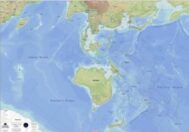
Australia has peeled back China trade coercion as it ramps-up the alliance with the United States to balance China. The Labor government, elected in May 2022, claims a diplomatic thaw with China as a key achievement. The major defense step was agreeing for Australia to get nuclear submarines under the AUKUS agreement with Britain and the United States. The government’s 2023 National Defense Statement describes “an intense contest of values” in the Indo-Pacific, with growing “risks of military escalation or miscalculation.” Because of the worsening strategic environment, the Australian Defense Force is judged “not fully fit for purpose” as the government seeks greater long-range strike capability. The era of alliance integration will see more US troops, planes, and ships in Australia, and the creation of a US-Australia combined intelligence center in Canberra. The contest with China in the South Pacific frames a new Australian aid policy and a greater US role in the islands.

Australia-US/East Asia
September 2021 — August 2022Australia’s New Government: Climate, China and AUKUS
Australia has changed government and the political war over climate change draws to a close after raging for 15 years. The new Labor government led by Anthony Albanese promises continuity on foreign and defense policy, delivered with a different tone. In the government’s first 100 days, it chipped some ice from the frosty relationship with China. Ending a Beijing ban on meetings with Australian ministers that was in its third year, Chinese ministers had face-to-face talks with Australia’s foreign minister and defense minister. Albanese’s observation that dealing with China will continue to be difficult was demonstrated by a diplomatic duel in the South Pacific, as Canberra pushed back at Beijing’s ambition for a greater security role in islands. Two major defense announcements are due in the first months of 2023: the plan for an Australian nuclear submarine, based on the AUKUS agreement with the US and UK, plus a re-set of Australia’s military and strategic posture because of the toughest security environment in decades. Labor says the alliance with the US should go “beyond interoperability to interchangeability” so the two militaries can “operate seamlessly together at speed.”
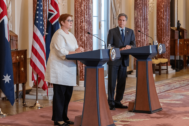
Australia-US/East Asia
September 2020 — August 2021COVID and China Chill, Alliance Anniversary and Afghanistan
Australia closed its borders to confront COVID-19 and rode out recession, while China shut off key markets to punish Australia. The short recession caused by pandemic ended Australia’s record run of nearly three decades of continuous economic growth; Beijing’s coercion crunched the optimism of three decades of economic enmeshment. However, Australia’s economy rebounded while the China crunch continues, causing Australia to question its status as the most China-dependent economy in the developed world. The Canberra-Beijing iciness has built over five years, marking the lowest period since the establishment of diplomatic relations in 1972. In 2021, the language of “strategic partnership” died and the “strategic economic dialogue” was suspended by China. The Biden administration promised not to abandon Australia, saying that US-China relations would not improve while an ally faced coercion. Australia embraced Washington’s assurance, along with the elevation of the Quad with the US, Japan, and India.
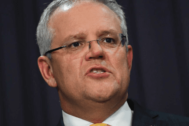
Australia-US/East Asia
September 2019 — August 2020Coronavirus, China and the US New Normal
Challenged by COVID-19 and China, Australia confronts deteriorating strategic prospects and its first economic recession in nearly 30 years. The pandemic has worsened strained relations between Australia and China. Canberra’s call for an inquiry into the origins of COVID-19 was attacked by Beijing as a betrayal and Chinese trade retaliation has followed. Even before the pandemic hit, Australia talked of a “new normal” with China of “enduring differences.” Whatever the US election result, the phrase “new normal” is also being applied to changes wrought by President Trump. The US alliance is hugged anew as Canberra abandons a central strategic tenet held for 50 years—the idea that Australia would have 10 years warning of any direct military threat.

Australia-US/East Asia
September 2018 — August 2019Scott Morrison, Donald Trump, and the Indo-Pacific
Echoing uncertain geopolitical times, Australian politics confounded opinion polls and pundits at the May 18 federal election. Re-election of the Liberal-National coalition government was a “miracle” result, according to Prime Minister Scott Morrison. The surprise victory transformed Morrison’s authority within his party and the country – and burnished his relationship with US President Donald Trump. Morrison says the shift in the US-China relationship from engagement to competition is “inevitable,” calling for the Indo-Pacific to deepen patterns of cooperation so the competition does not become adversarial. Australia was an early adopter of the Indo-Pacific concept, describing it as a useful geographic construct. Now Australia is embracing the Indo-Pacific not merely as construct, but as a US strategy – the Free and Open Indo-Pacific.
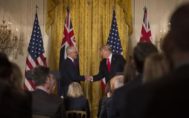
Australia-US/East Asia
September 2017 — August 2018Turnbull Tumbles, Trump Mateship, China Frost
In a week of political mayhem, Australia’s ruling Liberal Party dumped its leader, Prime Minister Malcolm Turnbull, and shunned its deputy leader, Foreign Minister Julie Bishop. While the political unrest is deeply domestic in nature, it shares one element with Australian’s foreign policy concerns – uncertainty. The Australia-US relationship under Donald Trump has been defined by what the president has NOT done to Australia. Trump hasn’t questioned the alliance; hasn’t hit Australia with trade tirades and tariffs; hasn’t broken the refugee deal he so denounced when first taking office; and hasn’t even sent an ambassador to Australia. Canberra’s softly-softly approach to Trump is to talk up the military history – “100 years of mateship” – stressing Australia is an alliance partner that doesn’t cost the US much. A major talking-point is that Australia has a trade deficit with the US. In the way that Trump defines trade relationships, the US makes a profit out of Australia. In contrast, the relationship with China has gone through an icy patch.
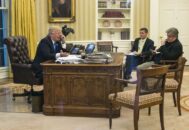
Australia-US/East Asia
May — August 2017The Donald Dichotomy: US Leadership Without the Leader
The uncertainty generated by President Donald Trump has made Australia cling ever tighter to the US alliance. The Trump effect hit Canberra within days of Trump taking office. The phrase “shock and awe” springs to mind – rendered in the alliance realm as “shake and appall.” The first phone conversation between Trump and Prime Minister Malcolm Turnbull was a version of “shake, rattle and roll.” Canberra wants to play nice with The Donald, and say nothing publicly that is critical of the president. The template for the Australian approach was on display early when the president withdrew the US from the Trans-Pacific Partnership. The Turnbull government expressed great regret at the decision but said nothing about the man who’d made it. While striving not to affront the president, Australia’s language about China has become shriller. Tongue-tied by Trump, Canberra gives stronger voice to concerns about China. Turnbull has referred to the “dark view” of a “coercive China” seeking Asia domination. Stern words about China’s threat to the rules-based system serve a dual purpose: speak to Beijing about the value of the system while implicitly pleading with the US not to abandon what it has built and policed – and mightily profited from.
Australia-US/East Asia
September — August 2016Turnbull, TPP, and Trump
While Malcolm Turnbull’s coalition government was narrowly returned to office in Australia’s 2016 election, Australia’s thinking about Asia’s future hinges on another election. Concern about the US presidential race has joined worries about Asia’s “rules-based order” and growing competition between the US and China. Not least of Australia’s fears is what US politics will do to the Trans-Pacific Partnership trade deal. Meanwhile, there were a few “surprises” between Australia, the US, and Japan that shaped relations over the summer months and will likely continue to influence them in the coming year.
Australia-US/East Asia
September 2014 — August 2015Alliance, Trade, Climate, and China
The Obama administration and the Abbott government stood together in the new military coalition in Iraq and joined in the trade push for a Trans-Pacific Partnership. Australia’s Defence White Paper, about to be released, will be a strong and detailed statement of support for the alliance with the US. Yet, the discussion of the US-Australia relationship often turned into a debate about China. The notable political difference between Obama and Abbott in the past 12 months was over climate change. The US president highlighted the policy difference in a speech during the G20 Summit that Abbott hosted in Brisbane. The other divergence between Australia and the US was over China’s creation of the Asian Infrastructure Investment Bank. After initially sharing US fears about the bank, the Abbott government eventually decided to abandon the US and Japan and became a founding member.
Australia-US/East Asia
May — August 2014China Bumps, Indonesia Breach, Japan as Ally
On the first anniversary of its election on Sept. 7, the Australian Coalition government’s foreign policy report card showed excellent relations with the US and Japan, a major diplomatic blow-up with Indonesia, and bumps with China. Tony Abbott’s government is completing the withdrawal of Australian forces from Afghanistan, but the alliance and humanitarian arguments are drawing Australia back toward Iraq. The US rebalance to Asia is seeing more Marines rotate through northern Australia, and the US has similar plans for its ships and planes. The growth of the US-Japan-Australia trilateral relationship has prompted one former prime minister to argue that Australia has more to fear from provocative actions by its trilateral partners than from China. For Australia today, to discuss the alliance is also to talk about China.
Australia-US/East Asia
May — August 2013Election plus Marines, Joint Facilities and the Asian Century
The past year saw the unfolding of the withdrawal timetable from Afghanistan, the second rotation of US Marines to northern Australia, the first “Full Knowledge and Concurrence” statement on US facilities on Australian soil in six years, and the end of Australia’s long-term military deployments in Timor Leste and Solomon Islands. The Gillard government produced a trio of major policy statements built on an understanding that Asia’s “extraordinary ascent” means Australia is entering “a truly transformative period in our history.” Meanwhile, Australian politics experienced a bit of turmoil. With the Labor Parliamentary Caucus in disarray, the Liberal-National Coalition led by Tony Abbot won the national election in early September. In the end, not being Julia Gillard or Kevin Rudd was enough for an Abbott triumph.
Australia-US/East Asia
May — August 2012Rebooting the Alliance
The Obama administration’s military rebalancing to Asia helped reboot the US alliance with Australia. Indeed, the arrival of US Marines in northern Australia put real boots into the reboot. The announcement that the Marines were heading for Darwin was the centerpiece of President Barack Obama’s visit to Australia in November. After the alliance intimacy achieved by two conservative leaders – George W. Bush and John Howard – it seemed unlikely that a Democrat president and a Labor prime minister could tighten the alliance bonds further. Obama and Gillard managed it, proving again the special status of the alliance for both sides of Australian politics. The Marine deployment became an important element in the broader debate in Australia about the emerging power system in Asia and the terms of Australia’s future relationship with its number one economic partner, China. Even in trade, Australia now faces different US and Chinese visions of the institutional framework for Asia’s future.
Australia-US/East Asia
October 2010 — August 2011Australia-US Alliance Enhanced as Economies Decouple
Australia has a close alliance with the US and deep emotional and cultural ties, but the new reality is that the two economies have decoupled. Twice in the past decade the US has gone into recession, but Australia has kept growing; that is a huge change from the 20th-century experience when Australia’s fortunes were closely tied to the health of the US economy. Asia now sets Australia’s economic temperature, even as the Australian military draws closer to the US through parallel reviews of the posture of their defense forces.
The great question for the alliance partners is how much they can still align their strategy and interests in what Canberra has started to describe as “the Asian Century.” All these elements could be detected when Australia’s Prime Minister Julia Gillard addressed the US Congress in March and finished her speech of praise for America with a memory of her schooldays in Adelaide. She said that Americans are still, “the same people who amazed me when I was a small girl by landing on the moon. On that great day I believed Americans could do anything. I believe that still. You can do anything today.”
Australia’s first female prime minister comes from the left of the Labor Party. But the tenor of her speech differed little from that of the Australian prime minister who took the same podium in Washington in 2002: Liberal Party leader John Howard. While Howard and Gillard are deeply contrasting personalities from the two poles of Australia party politics, on the US alliance they reflect a commitment and a consensus that has united both sides of Australian politics for decades. Even former Liberal Prime Minister Malcolm Fraser, who is most critical of the workings of the alliance, affirms the importance of the US relationship while lamenting that Australia is “too compliant” and “subservient” in its dealings with Washington.
Gillard was in Washington to mark the 60th anniversary of the signing of the ANZUS alliance. The health of the pact is shown by how it is evolving today: Australia’s defense minister says plans for greater US use of Australian military facilities will “be the single biggest change or advancement of alliance relationships” since the 1980s. The alliance, though, is also being reframed for Australia by the changes throbbing through Asia. These two themes define much of this review of Australia–East Asia/US relations: the continuing vigor of the alliance and the unfolding realization of what the “Asian Century” will mean for Australia.
Australia-US/East Asia
July — September 2010Australia Deposes a Leader and Hangs Parliament
In 2010, Australia saw a first-term-elected prime minister deposed by his own party and then a federal election that produced a hung Parliament. The Labor Parliamentary caucus removal of Prime Minister Kevin Rudd on June 24 ushered in Australia’s first female prime minister, Julia Gillard, who waited only three weeks after replacing Rudd before calling a national election, seeking her own mandate from the voters. Instead, the election on Aug. 21 returned the first hung Parliament since World War II. The new Labor government will live on the permanent brink of defeat – fearing an MP’s heart attack, a defection, a by-election. Gillard has won the right to negotiate for her policy preferences, not to impose them. Running a minority government will demand an almost unremitting domestic focus from Gillard. She has promised a more consultative, inclusive style of politics. The Australian Financial Review summed up the difference between the two leaders with this quote from a senior ministerial adviser: “Kevin governed from a two-man tent. Julia will need a marquee.” Style changes between the Rudd and Gillard governments will be marked. But policy continuity will often be the norm, especially in foreign policy.
Gillard fulfilled her promise to give Rudd a senior post in her government by appointing him foreign minister. The challenge for Rudd will be whether he can put aside his deep personal hurt – and the political habits that brought him down – to serve the woman who deposed him. To put the Canberra question in a Washington frame: Can Kevin do a Hillary? Can Rudd be a loyal and effective foreign minister following the example set by Hillary Clinton as secretary of State?
Australia-US/East Asia
July — September 2009Australia Adjusts to New Realities
Australia’s government swung from the right to the left of the political spectrum in 2007. The U.S. did the same in 2008. Yet, not much changed in the fundamentals of the 57-year-old U.S.-Australia alliance. The assertion of alliance continuity, however, comes with a major caveat: the tectonic effects being exerted by China’s rise. As with the rest of the Asia-Pacific, Australia is adjusting significant aspects of its foreign and security policy to the magnetic pull of China, which was dramatized for Canberra through the middle of 2009 by an outburst of Chinese official anger directed at Australia. Other important influences to consider include the so-called “Kevin Rudd” effect, the global economic crisis, and the ongoing conflicts in the Middle East.
Australia-US/East Asia
March 1996 — June 2003Mr. Howard Goes to Washington: The U.S. and Australia in the Age of Terror
As the planes struck on Sept. 11, 2001, Australian Prime Minister John Howard was in Washington for an official visit scheduled to mark the 50th anniversary of the ANZUS Treaty that formalizes the security alliance between Australia and the United States. He had met the president Sept. 10, and the two men had signed a statement affirming the vitality and strength of the bilateral strategic partnership between the two countries.
The poignancy of Howard’s presence in Washington that day, and the symbolic significance of the anniversary that he was there to celebrate, have lent weight to the view that the events of Sept. 11 mark a fundamental turning point in the dynamics of the U.S.-Australia relationship, with a much strengthened trend to an even deeper and closer alliance than before. This view in turn is often adduced to support a wider hypothesis: that Australia under John Howard is undertaking a fundamental realignment of its international relationships away from Asia and toward the U.S.
There is evidence, some of it quite compelling, to support these views. Certainly over the intervening 22 months since that tragic day, Australia has been second only to the UK in the warmth of its support for the Bush administration’s approach to the war on terror. The Howard government has put less rhetorical weight on Australia’s relationships in Asia than did its predecessor, Paul Keating. Even so, one must be careful. Relationships as old, deep, and complex as that between the U.S. and Australia have a tempo and a trajectory that are not easily transformed by individual events − even events as resonant as the terrorist attacks of Sept 11. It may be that the current phase of evolution of the U.S.-Australia alliance, while obviously affected by the dramatic contemporary context, is also, and to a greater degree, reflecting the influence of longer-term, slower-acting, but in the end, more powerful forces.